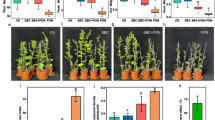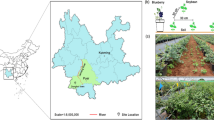Abstract
Rehmanniae glutinosa, an important medical plant in China, has distinct regional characteristics. It has long suffered from consecutive monoculture obstacles, resulting in severe reduction of quality and yield. The microbial community is believed to play an important role in the monoculture process. However, there are no reports on how microbial compositions change in response to growth of R. glutinosa. In this study, quantitative real-time PCR and metagenomic high throughput sequencing methods were applied for the first time to elucidate the rhizosphere microbial community variation during growth and consecutive monoculture of R. glutinosa. The results indicated that with the first- and second-year cultivated process, the bacterial and fungal populations varied dramatically in rhizosphere soil, and the microbial balance was severely altered. Some probiotic bacteria (e.g., Actinomycetes), obviously decreased in abundance with consecutive monoculture and the abundances of some pathogenic fungi (e.g., Alternaria) were obviously higher in the second-year cultivation than that in the first-year cultivation. In addition, we also found that microbial imbalance was tightly coupled with decreased soil pH and reductions in a series of soil enzyme activities. All these changes could be responsible for consecutive monoculture obstacles of R. glutinosa.
Similar content being viewed by others
References
Bainard L.D., Koch A.M., Gordon A.M. & Klironomos J.N. 2013. Growth response of crops to soil microbial communities from conventional monocropping and tree-based intercropping systems. Plant Soil 363: 345–356.
Burns R.G., DeForest J.L., Marxsen J., Sinsabaughd R.L., Strombergere M.E., Wallensteinf M.D., Weintraubg M.N. & Zoppinih A. 2013. Soil enzymes in a changing environment: Current knowledge and future directions. Soil Biol. Biochem. 58: 216–234.
Chen Z.Z., Yin Q.Y., Wang X.M. & Zou Y.J. 1997. Primary study on dynamics of soil microorganisms under soybean continuous cropping. Agr. Sci. China 30: 96.
Du J.F., Yin W.J., Zhang Z.Y., Hou J., Huang J. & Li J. 2009. Autotoxicity and phenolic acids content in soils with different planting interval years of Rehmannia glutinosa. Chinese J. Ecol. 48: 445–450. (In Chinese)
Ehrenfeld J.G., Ravit B. & Elgersma K. 2005. Feedback in the plant-soil system. Annu. Rev. Env. Resour. 30: 75–115.
El-Refai H.A., AbdElRahman H.Y., Abdulla H., Hanna A.G., Hashem A.H., El-Refai A.H., & Ahmed E.M. 2011. Studies on the production of actinomycin by Nocardioides luteus, a novel source. Curr. Trends Biotech. Pharm. 5: 1282–1297.
Feng Y.Z., Grogan P., Caporaso J.G., Zhang H.Y., Lin X.G., Knight R. & Chu H.Y. 2014. pH is a good predictor of the distribution of anoxygenic purple phototrophic bacteria in Arctic soils. Soil Biol. Biochem. 74: 193–200.
Frankenberger W.T. & Johanson J.B. 1983. Method of measuring invertase activity in soils. Plant Soil 74: 301–311.
Goudjal Y., Zamoum M., Meklat A., Sabaou N., Mathieu F. & Zitouni A. 2016. Plant-growth-promoting potential of endosymbiotic actinobacteria isolated from sand truffles ( Terfezio, leonis Tul.) of the Algerian Sahara. Ann. Microbiol. 66: 91–100.
Griffiths R.I., Thomson B.C., James P., Bell T., Bailey M. & Whiteley A.S. 2011. The bacterial biogeography of British soils. Environ. Microbiol. 13: 1642–1654.
Guan S.M. 1986. Soil Enzyme and the Methods about the Study of Soil Enzyme. China Agriculture Press, Beijing.
Hao D.C., Song S.M., Mu J., Hu W.L. & Xiao P.G. 2016. Unearthing microbial diversity of Taxus rhizosphere via MiSeq highthroughput amplicon sequencing and isolate characterization. Sci. Rep. 6: 22006.
Huang L.F., Song L.X., Xia X.J., Mao W.H. Shi K., Zhou Y.H. & Yu J.Q. 2013. Plant-soil feedbacks and soil sickness: from mechanisms to application in agriculture. J. Chem. Ecol. 39: 232–242.
Kaiser C., Koranda M., Kitzler B., Fuchsleuger L., Schnecker J., Steiger P., Rasche F., Zechtmeister-Boltenstern S., Sessitsch A. & Richter A. 2010. Belowground carbon allocation by trees drives seasonal patterns of extracellular enzyme activities by altering microbial community composition in a beech forest soil. New Phytol. 187: 843–858.
Kulichevskaya L.S., Suzina N.E., Liesack W. & Dedysh S.N. 2010. Bryobacter aggregatus gen. nov., sp. nov., a peat-inhabiting, aerobic chemo-organotroph from subdivision 3 of the Aci-dobacteria. IJSEM 60: 301–306.
Lauber C.L., Strickland M.S., Bradford M.A. & Fierera N. 2008. The influence of soil properties on the structure of bacterial and fungal communities across land-use types. Soil Biol. Biochem. 40: 2407–2415.
Lauber C.L., Hamady M., Knight R. & Noan F. 2009. Pyrose-quencing-based assessment of soil pH as a predictor of soil bacterial community structure at the continental scale. Appl. Environ. Microb. 75: 5111–5120.
Li P.D., Dai C.C., Wang X.X., Zhang T.T. & Chen Y. 2012. Variation of soil enzyme activities and microbial community structure in peanut monocropping system in subtropical China. Afr. J. Agrl. Res. 7: 1870–1879.
Li Z.F., Yang Y.Q., Xie D.F., Zhu L.F., Zhang Z.G., & Lin W.X. 2012. Identification of autotoxic compounds in fibrous roots of Rehmanniae (Rehmanniae a Libosch.). PLoS One 7: e28806.
Li X.Z., Rui J.P., Mao Y.J., Yannarel A. & Mackie R. 2014. Dynamics of the bacterial community structure in the rhizosphere of a maize cultivar. Soil Biol. Biochem. 68: 392–401.
Lim D.J., Yun S.J., Chung I.M. & Chang Y.Y. 2005. Resveratrol synthase transgene expression and accumulation of resveratrol glycoside in Rehmanniae. Mol. Breeding 16: 219–233.
Lu R.K. 2000. Analytical Methods on Agrochemical Properties of Soil. China Agricultural Science & Technology Press, Beijing.
Meriles J.M., Gil S.V., Conforto C., Figoni G., Lovera E., March G.J. & Guzmán C.A. 2009. Soil microbial communities under different soybean cropping systems: Characterization of microbial population dynamics, soil microbial activity, microbial biomass, and fatty acid profiles. Soil Till. Res. 103: 271–281.
Nannipieri P., Ceccanti B. & Cervelli P.S. 1974. Sequi Use of pyrophosphate to extract urease from a podzol. Soil Biol. Biochem. 6: 359–362.
Nielsen U.N., Osler Graham H.R. & Campbell C.D. 2010. The influence of vegetation type, soil properties and precipitation on the composition of soil mite and microbial communities at the landscape scale. J. Biogeogr. 37: 1317–1328.
Qin G.Z. & Tian S.P. 2004. Biocontrol of postharvest diseases of Jujube Fruit by Cryptococcus laurentii combined with a low dosage of fungicides under different storage conditions. Plant Dis. 88: 497–501.
Qu X.H. & Wang J.G. 2008. Effect of amendments with different phenolic acids on soil microbial biomass, activity, and community diversity. Appl. Soil Ecol. 39: 172–179.
Sláviková E., Vadkertiová R. & Vránová D. 2007. Yeasts colonizing the leaf surfaces. J. Basic Microb. 47: 344–350.
Ter Braak C.J.F. 1986. Canonical Correspondence Analysis: A New Eigenvector Technique for Multivariate Direct Gradient Analysis. Ecology 67: 1167–1179.
van Overbeek L. & van Elsas J.D. 2008. Effects of plant genotype and growth stage on the structure of bacterial communities associated with potato (Solanum tuberosum L.). FEMS Microbiol. Ecol. 64: 283–296.
Wu L.K., Wang H.B., Zhang Z.X. Lin R., Zhang Z.Y. & Lin W.X. 2011. Comparative metaproteomic analysis on consecutively Rehmanniaea-monocultured rhizosphere soil. PLoS One 6: e20611.
Wu L., Li Z., Li J., Khan M.A., Huang W.M. Zhang Z.Y. & Lin W.X. 2013. Assessment of shifts in microbial community structure and catabolic diversity in response to Rehmannia glutinosa monoculture. Appl. Soil Ecol. 67: 1–9.
Xu Y.X., Wang G.H., Jin J., Liu J.J., Zhang Q.Y. & Liu X.B. 2009. Bacterial communities in soybean rhizosphere in response to soil type, soybean genotype, and their growth stage. Soil Biol. Biochem. 41: 919–925.
Yang Q.X., Wang J., Wang H.T., Chen X.Y., Ren S.W., Li X.L., Xu Y., Zhang H. & Li X.M. 2012. Evolution of the microbial community in a full-scale printing and dyeing wastewater treatment system. Bioresource Technol. 117: 155–163.
Yurkov A.M., Kemler M. & Begerow D. 2012. Assessment of yeast diversity in soils under different management regimes. Fungal Ecol. 5: 24–35.
Zhang R.X., Li M.X. & Jia Z.P. 2008. Rehmanniaea: review of botany, chemistry and pharmacology. J. Ethnopharmacol. 117: 199–214.
Author information
Authors and Affiliations
Corresponding author
Supplemental data
11756_2016_71121320_MOESM1_ESM.pdf
Dynamic change of the rhizosphere microbial community in response to growth stages of consecutively monocultured Rehmanniae glutinosa
Rights and permissions
About this article
Cite this article
Yang, Q., Wang, R., Xu, Y. et al. Dynamic change of the rhizosphere microbial community in response to growth stages of consecutively monocultured Rehmanniae glutinosa. Biologia 71, 1320–1329 (2016). https://doi.org/10.1515/biolog-2016-0161
Received:
Accepted:
Published:
Issue Date:
DOI: https://doi.org/10.1515/biolog-2016-0161




